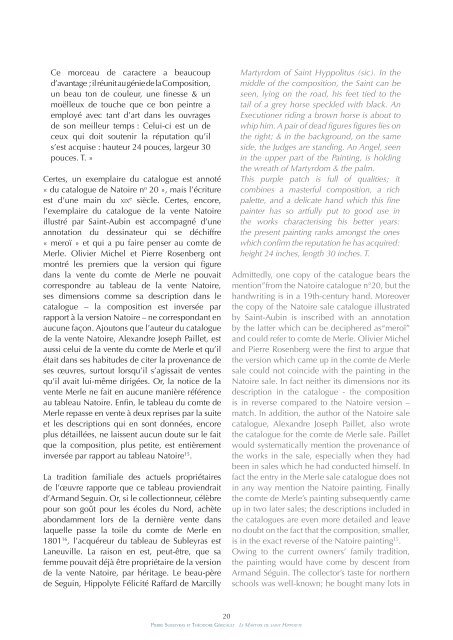You also want an ePaper? Increase the reach of your titles
YUMPU automatically turns print PDFs into web optimized ePapers that Google loves.
Ce morceau <strong>de</strong> caractere a beaucoup<br />
d’avantage ; il réunit au génie <strong>de</strong> la Composition,<br />
un beau ton <strong>de</strong> couleur, une finesse & un<br />
moëlleux <strong>de</strong> touche que ce bon peintre a<br />
employé avec tant d’art dans les ouvrages<br />
<strong>de</strong> son meilleur temps : Celui-ci est un <strong>de</strong><br />
ceux qui doit soutenir la réputation qu’il<br />
s’est acquise : hauteur 24 pouces, largeur 30<br />
pouces. T. »<br />
Certes, un exemplaire du catalogue est annoté<br />
« du catalogue <strong>de</strong> Natoire n o 20 », mais l’écriture<br />
est d’une main du xix e siècle. Certes, encore,<br />
l’exemplaire du catalogue <strong>de</strong> la vente Natoire<br />
illustré par <strong>Saint</strong>-Aubin est accompagné d’une<br />
annotation du <strong>de</strong>ssinateur qui se déchiffre<br />
« meroï » et qui a pu faire penser au comte <strong>de</strong><br />
Merle. Olivier Michel et Pierre Rosenberg ont<br />
montré les premiers que la version qui figure<br />
dans la vente du comte <strong>de</strong> Merle ne pouvait<br />
correspondre au tableau <strong>de</strong> la vente Natoire,<br />
ses dimensions comme sa <strong>de</strong>scription dans le<br />
catalogue – la composition est inversée par<br />
rapport à la version Natoire – ne correspondant en<br />
aucune façon. Ajoutons que l’auteur du catalogue<br />
<strong>de</strong> la vente Natoire, Alexandre Joseph Paillet, est<br />
aussi celui <strong>de</strong> la vente du comte <strong>de</strong> Merle et qu’il<br />
était dans ses habitu<strong>de</strong>s <strong>de</strong> citer la provenance <strong>de</strong><br />
ses œuvres, surtout lorsqu’il s’agissait <strong>de</strong> ventes<br />
qu’il avait lui-même dirigées. Or, la notice <strong>de</strong> la<br />
vente Merle ne fait en aucune manière référence<br />
au tableau Natoire. Enfin, le tableau du comte <strong>de</strong><br />
Merle repasse en vente à <strong>de</strong>ux reprises par la suite<br />
et les <strong>de</strong>scriptions qui en sont données, encore<br />
plus détaillées, ne laissent aucun doute sur le fait<br />
que la composition, plus petite, est entièrement<br />
inversée par rapport au tableau Natoire 15 .<br />
La tradition familiale <strong>de</strong>s actuels propriétaires<br />
<strong>de</strong> l’œuvre rapporte que ce tableau proviendrait<br />
d’Armand Seguin. Or, si le collectionneur, célèbre<br />
pour son goût pour les écoles du Nord, achète<br />
abondamment lors <strong>de</strong> la <strong>de</strong>rnière vente dans<br />
laquelle passe la toile du comte <strong>de</strong> Merle en<br />
1801 16 , l’acquéreur du tableau <strong>de</strong> Subleyras est<br />
Laneuville. La raison en est, peut-être, que sa<br />
femme pouvait déjà être propriétaire <strong>de</strong> la version<br />
<strong>de</strong> la vente Natoire, par héritage. Le beau-père<br />
<strong>de</strong> Seguin, Hippolyte Félicité Raffard <strong>de</strong> Marcilly<br />
<strong><strong>Marty</strong>rdom</strong> <strong>of</strong> <strong>Saint</strong> Hyppolitus (sic). In the<br />
middle <strong>of</strong> the composition, the <strong>Saint</strong> can be<br />
seen, lying on the road, his feet tied to the<br />
tail <strong>of</strong> a grey horse speckled with black. An<br />
Executioner riding a brown horse is about to<br />
whip him. A pair <strong>of</strong> <strong>de</strong>ad figures figures lies on<br />
the right; & in the background, on the same<br />
si<strong>de</strong>, the Judges are standing. An Angel, seen<br />
in the upper part <strong>of</strong> the Painting, is holding<br />
the wreath <strong>of</strong> <strong><strong>Marty</strong>rdom</strong> & the palm.<br />
This purple patch is full <strong>of</strong> qualities; it<br />
combines a masterful composition, a rich<br />
palette, and a <strong>de</strong>licate hand which this fine<br />
painter has so artfully put to good use in<br />
the works characterising his better years:<br />
the present painting ranks amongst the ones<br />
which confirm the reputation he has acquired:<br />
height 24 inches, length 30 inches. T.<br />
Admittedly, one copy <strong>of</strong> the catalogue bears the<br />
mention”from the Natoire catalogue n°20, but the<br />
handwriting is in a 19th-century hand. Moreover<br />
the copy <strong>of</strong> the Natoire sale catalogue illustrated<br />
by <strong>Saint</strong>-Aubin is inscribed with an annotation<br />
by the latter which can be <strong>de</strong>ciphered as“meroï”<br />
and could refer to comte <strong>de</strong> Merle. Olivier Michel<br />
and Pierre Rosenberg were the first to argue that<br />
the version which came up in the comte <strong>de</strong> Merle<br />
sale could not coinci<strong>de</strong> with the painting in the<br />
Natoire sale. In fact neither its dimensions nor its<br />
<strong>de</strong>scription in the catalogue - the composition<br />
is in reverse compared to the Natoire version –<br />
match. In addition, the author <strong>of</strong> the Natoire sale<br />
catalogue, Alexandre Joseph Paillet, also wrote<br />
the catalogue for the comte <strong>de</strong> Merle sale. Paillet<br />
would systematically mention the provenance <strong>of</strong><br />
the works in the sale, especially when they had<br />
been in sales which he had conducted himself. In<br />
fact the entry in the Merle sale catalogue does not<br />
in any way mention the Natoire painting. Finally<br />
the comte <strong>de</strong> Merle’s painting subsequently came<br />
up in two later sales; the <strong>de</strong>scriptions inclu<strong>de</strong>d in<br />
the catalogues are even more <strong>de</strong>tailed and leave<br />
no doubt on the fact that the composition, smaller,<br />
is in the exact reverse <strong>of</strong> the Natoire painting 15 .<br />
Owing to the current owners’ family tradition,<br />
the painting would have come by <strong>de</strong>scent from<br />
Armand Séguin. <strong>The</strong> collector’s taste for northern<br />
schools was well-known; he bought many lots in<br />
20<br />
Pierre Subleyras et Théodore Géricault Le <strong>Marty</strong>re <strong>de</strong> saint Hippolyte
















